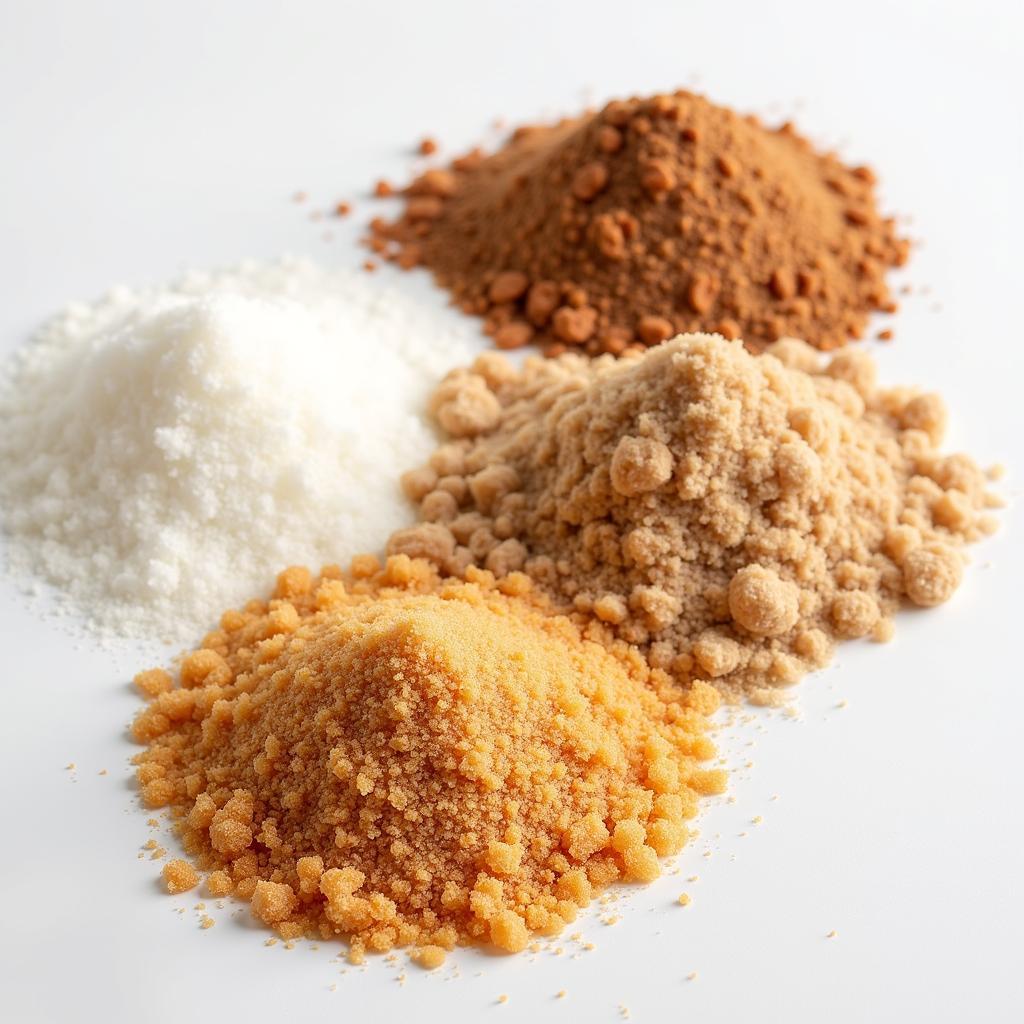De que color es el azucar? This simple question, meaning “what color is sugar?” in Spanish, opens up a surprisingly complex world of food science and culinary artistry. While most of us immediately picture pure white granulated sugar, the reality is that sugar can come in a spectrum of colors, from the purest white to deep, rich browns. Let’s explore the fascinating world of sugar and its diverse hues.
The Science Behind Sugar’s Color
The color of sugar is primarily determined by its level of refinement and the presence or absence of molasses. Sucrose, the scientific name for table sugar, is naturally colorless. It is extracted from sugarcane or sugar beets, which are then processed to separate the sucrose crystals from the rest of the plant material. This process involves several steps, including clarification, filtration, and crystallization.
From Plant to Crystal: The Sugar Refining Process
The journey of sugar from plant to crystal begins with extracting juice from the source, either sugarcane or sugar beets. This juice is then clarified to remove impurities, resulting in a lighter-colored liquid. Next, it undergoes a series of filtration and evaporation processes, concentrating the sucrose and further lightening the color. Finally, the concentrated syrup undergoes crystallization, where pure sucrose crystals are separated from the remaining liquid, known as molasses. The more molasses is removed, the whiter the sugar becomes.
 Sugar Refining Process: From Cane to Crystal
Sugar Refining Process: From Cane to Crystal
Molasses: The Key to Color Variation
Molasses, a thick, viscous byproduct of sugar refining, is responsible for the rich brown colors found in various types of sugar. It contains concentrated amounts of the non-sucrose components of the plant, including minerals, vitamins, and plant pigments. The more molasses present, the darker and more flavorful the sugar will be.
Exploring the Spectrum of Sugar Colors
From pristine white to deep, warm browns, the world of sugar offers a surprising range of colors, each with its own unique characteristics and culinary applications.
White Sugar: The Purest Form
White granulated sugar is the most common type of sugar, achieved through extensive refining that removes nearly all molasses. Its neutral flavor makes it versatile for a wide range of baking and cooking applications.
Brown Sugar: A Touch of Molasses
Brown sugar gets its characteristic color and flavor from the addition of molasses back to refined white sugar. Light brown sugar contains a smaller amount of molasses, while dark brown sugar has a higher molasses content, resulting in a richer color and more intense flavor.
 Different Types of Sugar: From White to Brown
Different Types of Sugar: From White to Brown
Raw Sugar: Unrefined Sweetness
Raw sugar is the least processed form of sugar, retaining some of the natural molasses from the plant. Its light golden brown color and subtle molasses flavor add a unique touch to recipes. However, it’s important to note that “raw” sugar still undergoes some processing and is not truly raw in the strictest sense.
Other Sugar Colors: Beyond the Basics
Beyond white, brown, and raw, there are other less common sugar varieties with unique colors, such as turbinado sugar and muscovado sugar. These sugars retain varying amounts of molasses, offering distinct flavors and color profiles.
What Color is Sugar, Really? It Depends!
So, de que color es el azucar? The answer isn’t always simple. While the default answer might be “white,” the reality is much more nuanced. Sugar’s color depends on its level of refinement and the amount of molasses present. This variety allows for a wide range of culinary possibilities, from the clean sweetness of white sugar to the rich, complex flavors of darker sugars.
“The beauty of sugar lies not just in its sweetness, but also in its diverse colors and flavors. Understanding these nuances allows you to truly unlock its culinary potential.” – Maria Sanchez, Pastry Chef and Culinary Instructor
FAQ
- Is brown sugar healthier than white sugar?: While brown sugar contains trace minerals from molasses, the amounts are negligible. Nutritionally, they are very similar.
- Can I substitute brown sugar for white sugar in recipes?: Yes, but the flavor and texture may be slightly different.
- What is the difference between turbinado sugar and raw sugar?: Turbinado sugar is partially refined, while raw sugar is less processed.
- How should I store different types of sugar?: Store sugar in an airtight container in a cool, dry place to prevent clumping.
- What is the best type of sugar for baking?: The best type of sugar depends on the specific recipe and desired outcome.
“Choosing the right sugar can elevate a dish from ordinary to extraordinary. Don’t be afraid to experiment and discover your favorite!” – David Rodriguez, Food Scientist and Author
Need help choosing the right sugar for your next culinary creation?
Contact us at Phone Number: 0373298888, Email: [email protected] or visit us at 86 Cầu Giấy, Hà Nội. Our 24/7 customer service team is here to help!
